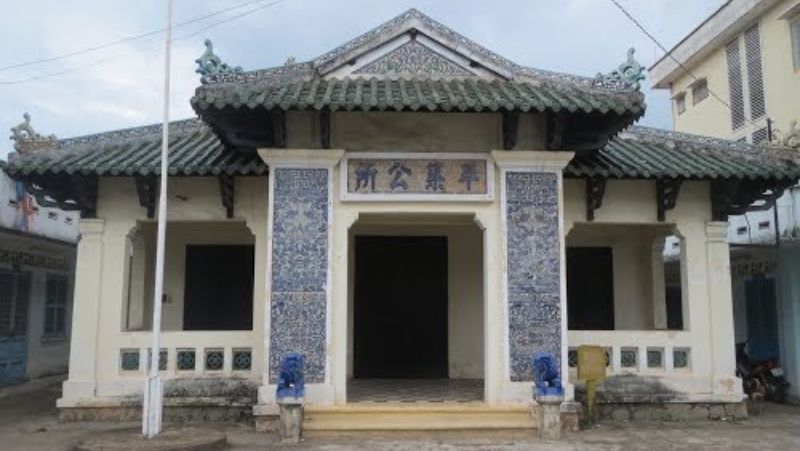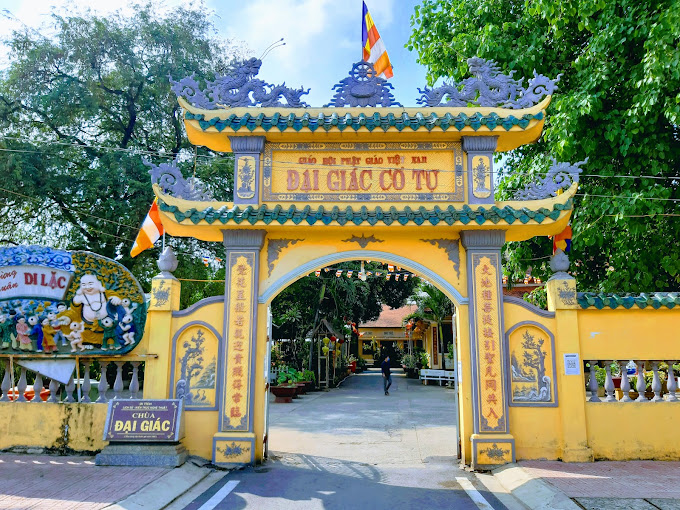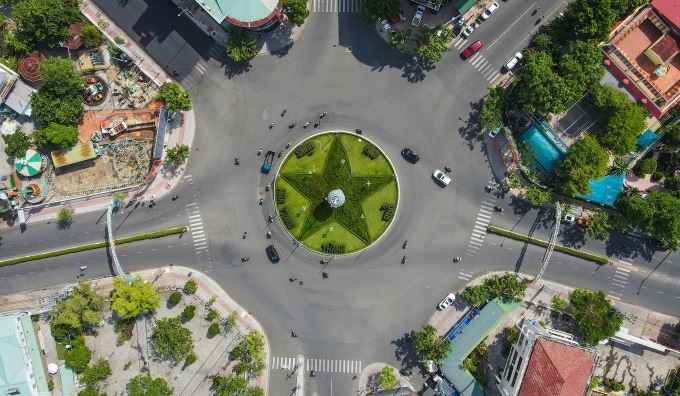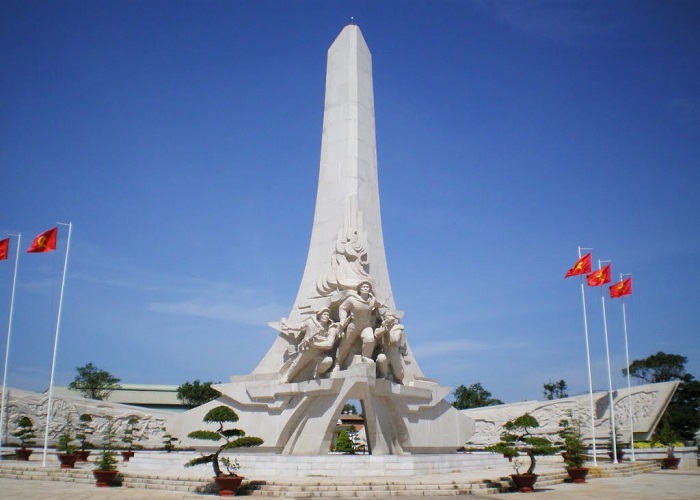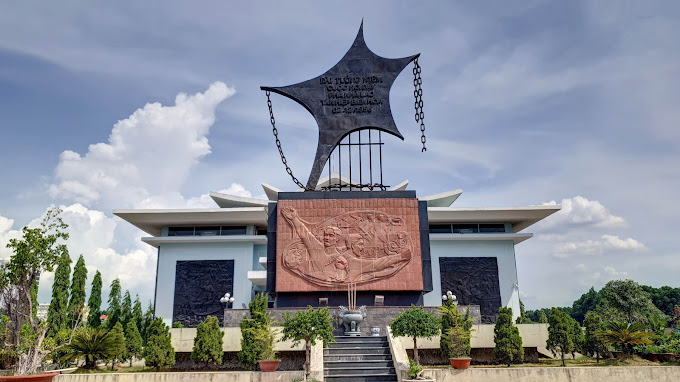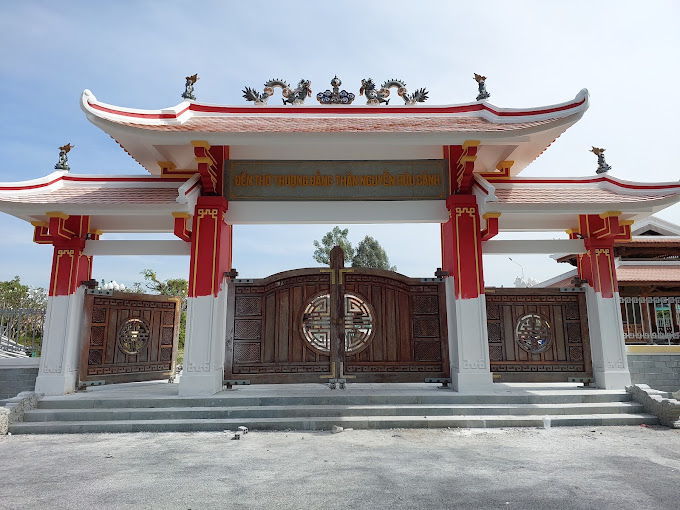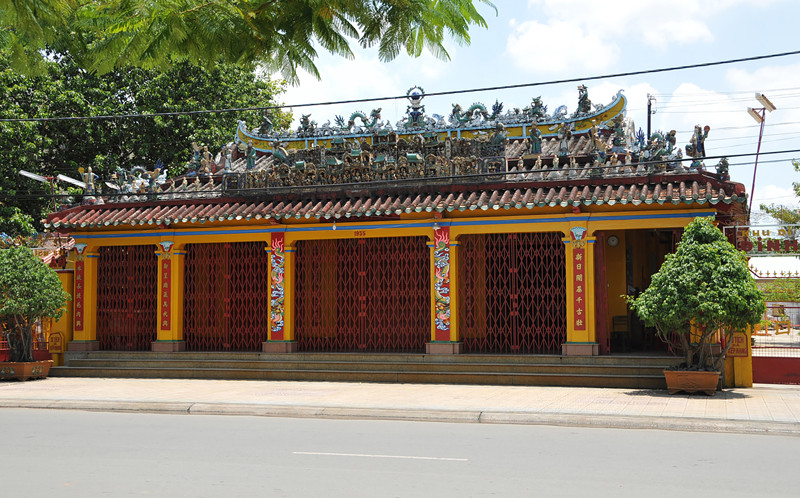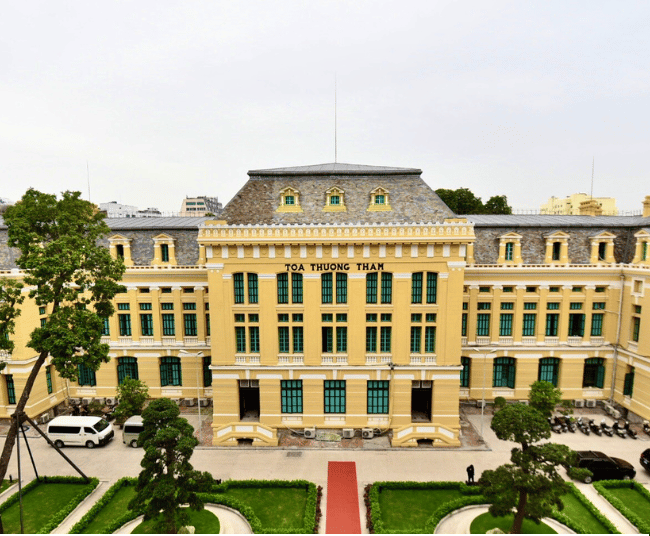Relic point Vietnam
Việt NamThe relics of the Binh Association first
The previous Binh Association relics belong to Binh before, Bien Hoa city, Dong Nai. This was a special architectural work of the village's village of the village before 1945. The Association was built around 1936 under the policy of the Governor of Bien Hoa Province Bolen. The previous association has become a meeting and working place of the local Qii. Located near the city center, the Binh Hoi house first attracted attention with folk architecture. Built by the artisan of pottery and construction of Bien Hoa, this monument stands out with sophisticated wooden sculpture and architectural works, reflecting the beauty of traditional Vietnamese art. Although it is not a temple communal house, the previous family still shows the solemn and unique features of the village architecture, combining many characteristics of the Nguyen Dynasty architectural art. With an area of 187.50m2, the architecture of the Association has yin and yang tile roofs, wooden decoration and sophisticated ceramic reliefs. More specifically, the previous Binh Association also marked an important event in Bien Hoa history. On September 23, 1945, the Bien Hoa Provincial Officer Conference decided to establish the first Provincial Party Committee after winning the government in August. This is one of the important events preparing for the resistance against France. The previous Binh Association relic was recognized by our State as a national cultural and historical monument on December 30, 1991. Source of Dong Nai Electronic Portal.
Dong Nai 2069 view
Dai Giac Pagoda (Dai Giac Co Tu)
Dai Giac Pagoda is also known as Dai Giac Co Tu, Big Buddha Pagoda or Tuong Pagoda; formerly belonged to Binh Hoanh village, Hiep Hoa commune, the Governor of Bien; Now is Nhi Hoa Quarter, Hiep Hoa Ward, Bien Hoa City, Dong Nai Province. Dai Giac Pagoda has an area of about 3,000 m2 with two gates built of bricks in and out, surrounded by fences. After many restoration, the pagoda is now in the way of Tam (三 三) with three horizontal houses connecting each other. The front of the pagoda rotates in the Northwest direction overlooking the Dong Nai River. In the middle of the pagoda, it was a large Bodhi tree, planted by Venerable Dinh Tong on the full moon day of November of the Year of the Rabbit (1939) and the statue of the Nam Hai Buddha stood on the lotus. On the left and behind is a large garden planting fruit trees, the right side is the stupa area with many tower tombs of the abbot. Although outside, the temple awnings are low and have modern architecture, but inside the temple, there is still a model of the ancient temples in Dong Nai, with round and towering columns, creating an open space. The pagoda includes the main hall, guest houses, monks, boys and kitchen. The main hall is a large three house, used to worship. Mid-space: On the top is the Buddha image of Amitabha of 2.25 m high, the bottom is the Buddha Shakyamuni Buddha and Buddha Di-Lat. The nearby door is a pharmacist Buddha lamp consisting of 49 small oil lamps with 49 small wooden Buddha statues, foot and trusses that carved very well. The left space is Khanh worshiping the Bodhi-Bodhisattva ancestor. On the right is Khanh worshiping the Emperor Quan Quan. On both sides of the wall, each side worships the five Kings and two judges. Behind the main hall is the altar of the ancestors who have been propagating at the pagoda, including many of the long-term Zen masters, including the oldest of the oldest monks who are Zen Master: Thanh Dang (Lam Te 34), Italian-Linh Nhac, Lieu-Tham Truyen (35), Indian Hoang Hoang (generation 36) ... Connected to the main hall of the Palace, the Buddhist worship ... Dai Giac Pagoda, along with Buu Phong pagoda and Long Thien pagoda, are three Vietnamese religious architectural works, built the earliest in Dong Nai and is the testimony for the Nam Tien road in the first half of the 17th century of the three monks of Lam Te in Dang Trong. In addition to this value, at Dai Giac Pagoda, there are Buddha statues, diaphragm, tangi, reliefs ... with many rich topics, elaborately carved, painted golden cards. All have shown the engraving talent of the creator and reflect more or less traditional art of the Southeast. With the above values, Dai Giac Pagoda has been ranked as a national historical and artistic monument under Decision No. 993/Decision, signed on September 28, 1990. Source of Dong Nai Electronic Portal.
Dong Nai 2055 view
River Street Square
Song Pho Square Relics was ranked a national historical relic by the Ministry of Culture, Information and Sports on December 30, 1991. Song Pho Square (also known as Song Pho Construction Site) is the intersection area of two routes Cach Mang Thang Tam and April 30 Street. People often call Song Pho Square with the affectionate name Central Roundabout. because it is located near the provincial offices and from here there are roads radiating to locations in Bien Hoa city. After conquering and pacifying Bien Hoa in the early twentieth century, the French colonialists built many offices on this land to serve the colonial government. Song Pho Square was built with the architecture of the Bien Hoa Palace and the Provincial Governor's Palace, creating a harmonious scene in the heart of a moderate-sized city on the romantic Dong Nai River. The fountain is a ceramic work created by Bien Hoa ceramic artist. The fish in the dragon position pose in the water and look beautiful through the sprayed water jets. Song Pho Square has entered the history of Bien Hoa since the exciting days when the masses rose up to seize power in the fall of 1945. On August 27, 1945, a solemn rally to welcome the revolutionary government took place here. The first provisional of Bien Hoa province. Nearly ten thousand people from all over came here to attend. In the surging atmosphere of revolutionary victory, comrade Duong Bach Mai - Officer of the Southern Party Committee representing the Viet Minh Front in the South gave a speech about the Party's revolutionary policy, which was warmly welcomed by the masses. Comrade Hoang Minh Chau, Chairman of the Uprising Committee, declared the government to be in the hands of the people and announced the Provisional Revolutionary People's Committee of Bien Hoa province consisting of comrades: - Hoang Minh Chau - Chairman - Huynh Van Hon - Vice President and Head of Propaganda Department - Nguyen Van Long - In charge of the police - Ngo Ha Thanh - In charge of national self-defense (Provincial Police) - Nguyen Van Tang - In charge of the Provincial National Asset Management Board The rally ended with the oath-taking ceremony. More than 10,000 people, on behalf of 150,000 compatriots in Bien Hoa province, raised their fists and took an oath, ready to sacrifice their lives and property, resolutely protecting the independence and freedom of the country. At the end of the rally, the crowd chanted the slogans "Long live Vietnam's independence" and "Long live the Viet Minh". The rally ended, tens of thousands of compatriots marched to demonstrate their strength. The group of people mixed with flags, flowers and banners was truly heroic. The whole town of Bien Hoa seemed to awaken and revive after many years of being oppressed and dominated by the enemy. Song Pho Square exists in the hearts of Bien Hoa people as a symbol of victory, somewhere there is still the joyful atmosphere of the autumn of the August Revolution in 1945. A century has passed with many changes. The fountain (Song Pho construction site) is still there, contributing to beautifying the city, and is the pride of Bien Hoa people. Source: Dong Nai province electronic information portal
Dong Nai 4329 view
Dong Xoai Victory Site
Dong Xoai Victory Site Relic is located in Tan Phu ward, Dong Xoai city, Binh Phuoc province. In early 1965, after the Binh Gia victory and the collapse of the US "special war" strategy, the struggle movement of our people in the South had a new development. The Military Commission and the Regional Command decided to open the Phuoc Long - Dong Xoai Campaign. Dong Xoai was chosen as the key battlefield of the campaign. To prepare for the campaign, logistics were carefully prepared. The people actively contributed their human and material resources, focusing on ensuring workers, food, food... It can be said that in the days of preparation for the Dong Xoai Campaign, the entire Phuoc Long mountain forest did not sleep day and night. The sound of pestles pounding rice, the light of torches and umbrellas, the sound of footsteps, voices, and laughter of citizens... all have created a complete picture of all the people working in logistics, all the resistance fighters of the ethnic minorities in the forest. mountains of the Southeast region. Directly participating in the battle at the strategic direction of Dong Xoai were Regiment 1 (Q761), Regiment 2 (Q762), Regiment 3 (Q763) of the main force Division 9... Many soldiers wrote slogans on their hats, on the butt of the gun with the following content: "Determined to liberate Dong Xoai", "Severely injured, do not scream, slightly injured, do not leave the battlefield" or "Determined to finish Dong Xoai, if not finished, Dong Xoai will not return". The battle of Dong Xoai branch took place in 3 days, starting from June 9, 1965 to June 12, 1965, we completed the task of attacking and destroying Dong Xoai branch. The Dong Xoai victory along with the Binh Gia and Ba Gia victories contributed to the complete defeat of the US imperialist "Special War" strategy and "added a glorious page to the history of the struggle of the Democratic Front". The Liberation Nation of South Vietnam opposes the war of the American Empire's invasion. Dong Xoai Victory Site Relic was built in 2005 with a total area of 16,932.88 m2, including construction items: Victory monument, relief paintings, souvenir gallery, green tree system, fountain water... A part of the heroic history of the Phuoc Long - Dong Xoai Campaign has been recreated at the monument with the image of 3 soldiers in a coordinated combat position, rushing to fight, portraying the true fighting spirit. have a cold. Behind the monument, two bas-reliefs illustrate the spirit of the fiery Dong Xoai battle in the past by vividly recreating the panoramic view of all aspects of the preparation process, the progress of the attack, and the moment of the army's victory. and our people. With great historical values, the Dong Xoai Victory Site relic was decided by the Minister of Culture, Sports and Tourism to rank as a national historical relic on December 12, 2014. Source: Binh Phuoc Provincial Museum Electronic Information Page
Dong Nai 4133 view
Tan Hiep Prison Historical Relic
Tan Hiep Prison, also known as "Tan Hiep Correctional Center", is located in Quarter 6, Tan Tien Ward, Bien Hoa City. Tan Hiep Prison Relic was ranked as a national relic by the Ministry of Culture and Sports on January 15, 1994. Tan Hiep Prison is one of the six largest prisons in South Vietnam and the largest prison in the Southeast region, built in an important military position, northeast of Bien Hoa town. Ahead is National Highway 1; Behind is the North - South railway line. This is an isolated location, convenient for transportation, easy for protecting, guarding, receiving prisoners from other places and transferring prisoners to Con Dao, Phu Quoc... Tan Hiep Prison has an area of 46,520 square meters with 8 prisons, including 5 prisons for communist prisoners and patriots. The prison is surrounded by 4 layers of barbed wire with 9 bunkers, 3 watchtowers with a team of guards and a modern alarm system. It's called "Correctional Center" but inside is actually a gun warehouse, an interrogation and torture room with the most modern tools. Each prison only has an area of nearly 200 square meters but holds 300-400 people, sometimes up to a thousand people. In particular, there are "repentance" rooms and "tiger cages" that are very small and narrow and living conditions are extremely harsh, prisoners live like in a crematorium. The diet was extremely unhygienic. The prison guards bought rotten rice and rotten fish to fertilize the fields, and fried them in oil to feed the prisoners, leading to many people being poisoned. With the determination to escape the imperial prison, return to the Party and the people to continue fighting and liberating the nation, on December 2, 1956, with the agreement of the Eastern Inter-Provincial Party Committee, the soldiers Communists were "detained" in Tan Hiep prison under the direct direction of comrade Nguyen Trong Tam (Bat Tam) - in charge of the prison Party Committee and a number of other comrades who suddenly broke the shackles. was able to free nearly 500 comrades and patriots. This event caused a stir in the Pentagon. America - Diem hastily mobilized both main forces and security forces, civil guards defending the three provinces of Bien Hoa, Ba Ria, Thu Dau Mot and two special forces to encircle and capture the prisoners, but all were defeated. failure. Our comrades and compatriots who escaped from Tan Hiep prison received help and protection from local facilities and returned safely to base. Among the escaped prisoners were comrades: Bay Tam, Hai Thong, Ly Van Sam... who became the core nucleus of the Dong Khoi movement later. In 2001, to partly recreate the crimes of the US - Diem against our comrades and compatriots imprisoned at Tan Hiep prison and describe the entire Tan Hiep uprising on December 2, 1956. , Dong Nai Museum has collected images, documents, and artifacts displayed at the relic and made a model to serve the research and sightseeing needs of all classes of people. Every day, the monument is open to visitors. Source: Dong Nai Electronic Newspaper
Dong Nai 12021 view
Nguyen Huu Canh Temple
Nguyen Huu Canh temple, also known as Binh Kinh communal house, is located on the left bank of Dong Nai river, formerly belonging to Binh Kinh hamlet, Binh Hoanh village, Tran Bien canton, now Nhi Hoa hamlet, Hiep Hoa commune, Bien Hoa city. It was ranked as a national historical relic by the Ministry of Culture, Information, Sports and Tourism on March 25, 1991. Nguyen Huu Canh Temple was built around the end of the 18th century. Initially, the temple was small in scale, with walls made of boards and a yin-yang tile roof, about 400m south of the current temple. Documents say: the temple was first rebuilt in the fourth year of Tu Duc (1851); By 1923, the temple was rebuilt at its current location. Nguyen Huu Canh was born in 1650 in Gia Mieu, Tong Son district, Thanh Hoa province in a family with many famous generals in the dynasty. He was a man of both literature and martial arts, accomplished many great victories and was trusted, loved and respected by Lord Nguyen. In the spring of the year Mau Dan (1698), he obeyed Lord Nguyen's order to invade Dang Trong while it was still very desolate. Arriving in Dong Nai, he set up his headquarters at Cu Lao Pho (now Hiep Hoa commune); took Dong Nai land as Phuoc Long district, built Tran Bien palace, took Saigon land as Tan Binh district, built Phien Tran palace, the land expanded thousands of miles. He recruited immigrants to settle down, organized the administrative apparatus gradually and systematically, encouraged land reclamation, and promoted Cu Lao Pho to develop into one of the busiest and most dynamic port towns throughout the century. 18 and officially annexed the new land of the South into the Dai Viet map. After returning from the invasion of the South, the following year he again served Lord Nguyen Phuc Chu's command to lead an army to suppress King Chan Lap and maintain the southern border region. In April of the year Canh Thin (1700), after completing his mission, on the way back to Rach Gam (Tien Giang), he fell ill and passed away on the 16th day of the 5th lunar month, at the age of 51 years old. On the way to his hometown for burial, his coffin was stopped at the land where he once had his headquarters on Cu Lao Pho so that local people could have the opportunity to say goodbye to him one last time. At the mandarin's communal house, local people built a tomb to remember this event. When hearing the news of Nguyen Huu Canh's death, Lord Nguyen was extremely sorry and conferred on him the title of High-ranking official of the Town Chancellor with the title: Thanh Marquis Ceremony and had his tablet enshrined at the Thai temple. Source: Dong Nai Electronic Newspaper
Dong Nai 9809 view
Tan Lan Communal House Historical Relic Area
Tan Lan Communal House is located on Nguyen Van Tri Street, Hoa Binh Ward, Bien Hoa City. Since its construction, the people took the name of the village, Tan Lan, to name the communal house. Through many ups and downs of history, the local name has changed many times, but the communal name still exists today. Legend has it that originally Tan Lan communal house was a small temple in Ken citadel, built by villagers during the reign of King Minh Mang to pay tribute to Tran Bien, admiral of general Tran Thuong Xuyen, who had great merit in exploring the land. belt and expand trade in Dong Nai - Gia Dinh region. After two moves (in 1861 and 1906), the communal house is in its current location. The front porch faces the windy Dong Nai river. The architecture of the communal house is in the style of a triangle consisting of three compartments: the vestibule, the main hall and the harem connected one after another. The main hall is decorated with altars, decorated with horizontal panels, parallel sentences, and wooden panels on large ironwood columns that are delicately carved and have artistic value. The vestibule roof is a unique work of art with ceramic paintings of hundreds of statues of people and objects representing vivid historical stories. The harem is divided into three compartments, the middle worships the Immortal Master, the two sides worship the Vietnamese Ancestors and the Chinese Immortals. The main object of worship in the communal house is the admiral and general Tran Thuong Xuyen. The main altar is solemn with a simple but majestic statue of a god on a lacquered and gilded throne. There are bronze sacred beasts standing around. In front of the god altar is a council table and two sets of bronze bowls. The two sides of the main hall are arranged with altars to worship the left and right banquets. Along the left and right walls, there are altars for eunuchs, queens, white horses and predecessors. Tran Thuong Xuyen was formerly the General of the three continents Cao - Loi - Liem under the Ming Dynasty (China). In 1679, the general guarding the water areas in Long Mon, Guangdong province (China) was Duong Ngan Dich and deputy general Hoang Tan; Together with the General Guard of the provinces Cao, Loi, Liem and Tran Thang Tai (ie Tran Thuong Xuyen) and deputy general Tran An Binh, they brought over 3,000 soldiers and family members, over 50 warships into the Tu Dung and Da estuaries. Nang asked the Nguyen lords for asylum in Vietnam. This was a group of Chinese people who were loyal to the Ming Dynasty and refused to submit to the Qing Dynasty, so they rebelled and waved the flag "anti-Manchu and submitted to the Ming Dynasty" but failed. Seeing that they were in a desperate situation, Lord Nguyen approved allowing them to immigrate... Lord Nguyen Phuc Tan "... then ordered a banquet to be held for them, comforting, praising, and providing medical care to the generals. They were given new mandarins and titles, and ordered to move into Dong Pho land to expand that land. They were guided by generals Van Trinh and Van Chieu, along with Duong Ngan Dich's Long Mon soldiers and soldiers, entering Loi Lap gate, following them. Dai and Tieu estuaries settled in My Tho. Soldiers and generals Cao, Loi and Liem of Tran Thuong Xuyen and Tran An Binh entered Can Gio estuary and then settled in Ban Lan, Dong Nai (Bien Hoa). Nowadays)". With a group of Vietnamese immigrants who arrived first, Tran Thuong Xuyen gathered Chinese merchants to build streets and create commercial establishments, making Nong Nai Dai Pho commercial port (Cu Lao Pho) once considered "the capital of Vietnam". "the most prosperous" association in the South at that time. Tran Thuong Xuyen is one of the people who made great contributions to the exploration and construction of the Dong Nai - Gia Dinh area. Regarding military activities, Tran Thuong Xuyen was a brave and strategic general who repeatedly commanded troops, kept the southern border safe, and expanded Vietnam's borders. Tran Thuong Xuyen died on the 23rd day of the 10th lunar month around 1720 (Canh Ty). Remembering the merits of Tran Thuong Xuyen, the Nguyen dynasty bestowed the noble title "Nguyen vi king, Tran vi general, great meritorious minister" (meaning: the Nguyen family is king, the Tran family is general, the success will never last. end), was ordained "Superior God" by King Minh Mang and Thieu Tri. In many places in the South, people have built temples to worship him, worshiping him as the country's deity. Source: Dong Nai Electronic Newspaper
Dong Nai 5343 view
Trinh Hoai Duc Tomb Relics
Trinh Hoai Duc Tomb is located in Quarter 3, Trung Dung Ward, Bien Hoa City, Dong Nai Province. Ranked as a national historical relic by the Ministry of Culture, Information, Sports and Tourism on December 27, 1990. Under the Nguyen Dynasty, Trinh Hoai Duc's tomb was located in Binh Truc village, Tran Bien palace. During the French colonial period, it was changed to Binh Truoc, in Chau Thanh district, Bien Hoa province. In 1938, Trinh Hoai Duc's mausoleum was classified as a relic by the Far East School. Local people often call it "Mr. Mausoleum" and there are many ancient tombs built of compound laterite. Many people believe that this was previously the tomb of the Trinh Hoai Duc family. The tombs are all built in the shape of an elephant, with a rectangular block plan; The stone steles engraved with Chinese characters face southwest, the walls are covered with green moss. In the entire Trinh family tomb area, Trinh Hoai Duc's tomb stands out because of its architectural scale, perhaps this was the intention of the tomb builders in accordance with the ancient principles of family lineage. Before 1975, every year during the Qingming Festival, Trinh Hoai Duc's descendants from other localities came to pay their respects with solemn ceremonies. Later, there was a ceremony because some descendants of the Trinh family had grown old or wandered, so the visiting ceremonies were no longer maintained as before. In 1998, on the occasion of the 300th anniversary of the formation and development of Bien Hoa - Dong Nai, Trinh Hoai Duc's tomb was restored and embellished. The original tomb architecture was preserved, surrounded by a solid citadel. Behind the tomb is a raised wall, forming a wavy oval shape. On the wall is an inscription in Chinese characters that resembles a poem praising Trinh Hoai Duc's virtue, but it has faded over time and is no longer readable. Both sides are decorated with two insulated dragon heads. Currently, this wall is decorated with a hidden dragon pattern. In front of the tomb entrance is a large screen, engraved with Trinh Hoai Duc's biography and career. On the square pillars connecting the walls of the citadel in front of the tomb, Chinese couplets are carved, the content is mainly about history and Trinh Hoai Duc's erudition in research. Inside the citadel is the main element of architecture, consisting of two parts: Graves: one of Trinh Hoai Duc and one of the main wife, surnamed Le. The structure of the tomb is the same, shaped like an elephant, surrounded by a horseshoe-shaped edge, in front of each grave is a stone stele, engraved with Chinese characters; The surrounding area is decorated with lines of text, yin and yang symbols, and the bottom is embossed in the form of a kneeling leg. The contents of the steles at Trinh Hoai Duc's two graves briefly state the titles, positions, ranks, and titles that Trinh Hoai Duc was bestowed with, along with his wife; Stele: also clearly states the time is November of the year At Dau, children Trinh Thien Le Nhien, Trinh Thien Nhien Bao, and Trinh Thien Bao jointly established the stele. Trinh Hoai Duc, a great talent, a great personality, has contributed to laying the foundation for a circle of pride in Dong Nai - Dong Nai Culture, which is the pride of Dong Nai people. Source: Dong Nai province electronic information portal
Dong Nai 7079 view
An Hoa communal house relic, Dong Nai
An Hoa communal house relic is a communal house with a long history when it was built in the late 18th century, located in An Hoa commune, Long Thanh district, on the banks of Dong Nai river. An Hoa Communal House was built by the people of the village in 1792. It was originally a small temple located on the left bank of the Dong Nai River, worshiping the Thanh Hoang. Over time, An Hoa communal house has shown signs of deterioration and was restored and renovated many times in 1944, 1953, 1994 and 2009. Currently, the communal house is located on a campus of nearly 3,000 square meters. In addition to intangible values and wood carving art, the communal house also has typical value in terms of architectural and artistic scale typical of Southern village communal houses in the 18th century in Dong Nai. The communal house preserves the characteristics of national architecture quite intact, not influenced by Chinese architecture like some other communal houses in the area. Accordingly, the vestibule overlooks the Dong Nai river to welcome fresh breezes. The communal house's architectural layout is arranged in the shape of the letter Cong, including the main hall, the Senior House and the Guest House. In addition, the communal house also has a martial arts house built separately in front facing the main hall. This is also the place where artistic performances and lion - lion - dragon dances take place during communal ceremonies. The communal house's architectural items include four-pillar houses (square houses) and slanted houses using traditional tenon joining techniques to create a solid, highly resistant frame. The communal house's roof is covered with yin-yang and fish-scale tiles, and the floor is tiled with Chinese tiles. The edge of the roof is decorated with motifs of dragons flanking the sun and carp turning into dragons made of green glazed ceramics, symbols of clouds, rain, thunder and lightning, expressing the wish for good weather, a good harvest, and everything going smoothly... An Hoa Communal House is a rare communal house that retains its architectural features and sophisticated wood carving art with motifs and themes such as: dragon hidden in the clouds, fish crossing the dragon gate, chrysanthemums, apricot trees, bats holding fruit, water waves... on system of rafter ends, cross beams, hammock doors and worship sites. This also symbolizes the wish for good weather, a peaceful nation, and a peaceful life for the agricultural and fishing residents of Ben Go village. Before 1945, communal houses were the administrative headquarters of communes and villages, where community activities were organized. After the liberation of the South, the communal house became a meeting place and organized community cultural activities managed by the An Hoa Commune's Welfare Committee. According to the House's Noble Committee, through the ups and downs of times and life's fluctuations, the communal house's artifacts are basically still preserved and protected, but some antiques are also lost. Every year, on the full moon day of the 8th lunar month, a ceremony to worship the God of the Gods takes place, with the wishes of a peaceful country and people, good weather, prosperous business, and a prosperous and happy life. On January 21, 1989, An Hoa communal house relic was recognized by our state as a national historical and cultural relic. Source: Dong Nai Electronic Newspaper
Dong Nai 4779 view
Long Khanh Dong Nai Administrative Court
The Long Khanh Provincial Administrative Building relic located on Cach Mang Thang Tam street, Xuan An ward, Long Khanh town, was ranked a national historical relic by the Ministry of Culture on November 16, 1988. Long Khanh Administration Building has a total area of 9,000 square meters, built in 1965 in French-style architecture, including a ground floor and an upper floor. This was the highest working headquarters of the American puppet in Long Khanh province at that time. In March 1975, the US - puppet government built the strategic defense line of Phan Rang - Xuan Loc - Tay Ninh to prevent the advance of our troops along the North-East gateway to Saigon. Long Khanh Administrative Building was chosen as the control center for all military activities of this defense line. Thoroughly grasping the ideology of the Party Central Politburo, the Regional Command decided to launch the Xuan Loc campaign to liberate Long Khanh town, destroy the enemy's strategic defense line, and advance to liberate Saigon. On April 9, 1975, 5 hours after the campaign started, a major battle took place at the Long Khanh Administrative Building. Comrades Pham Le Canh, Nguyen Van Trong, battalion 5; Nguyen Thanh Son, Nguyen Minh Duc, the 7th battalion of Regiment 266 of the 341st Division's assault spearhead led by comrade Tran Van Tran, attacking from the north of the town, planted the flag "Determined to win, determined to win" on the top of the flagpole. on the 1st floor of the Administration Building. This is a historic turning point victory for the Vietnamese revolution and the pride of the people of Long Khanh in the resistance war against America to save the country. After the liberation of the South on April 30, 1975, Long Khanh province was reorganized into Xuan Loc district. The Administration Building was repaired and became the headquarters of the People's Committee of Xuan Loc district. In 1991, Long Khanh district was separated from Xuan Loc district, the Administrative Building became the headquarters of the People's Committee of Long Khanh district. In 2004, the Administration Building was assigned to the Department of Culture, Sports and Information of Long Khanh town to manage and use: The ground floor is a library to store documents to serve readers, the upper floor is a traditional gallery with 176 documents and artifacts. Every year it attracts about 500 visitors, researchers and students. Source: Dong Nai Electronic Newspaper
Dong Nai 7002 view
